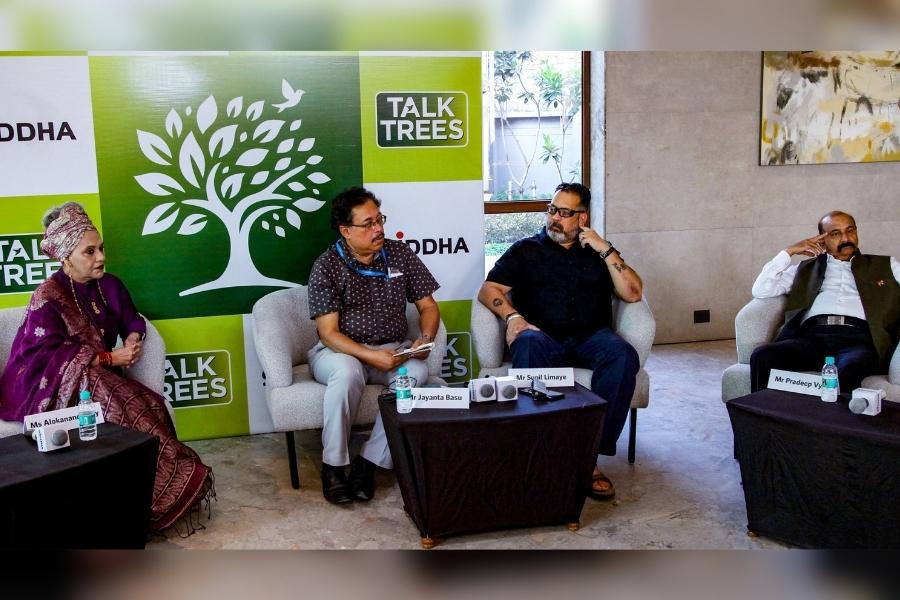On March 28, the Siddha Group organised an engaging session at Siddha Sky Club in Tiljala off EM Bypass, where panelists discussed pressing issues on the topic ‘Forest Land Depletion and Urban Wildlife Encounters’.
The chief speakers on the panel were retired Indian Forest Services (IFS) officers Sunil Limaye, former Principal Chief Conservator of Forest, Government of Maharashtra; and Pradeep Vyas, former Principal Chief Conservator of Forest, Government of West Bengal. The discussions were moderated by environmental writer Jayanta Basu, faculty member at the Department of Environmental Studies & Department of Journalism, Calcutta University. The panel also features danseuse Alokananda Roy, actress Rituparna Sengupta and actor Indraneil Sengupta.
Urbanisation and human-animal conflict
The panel began with a discussion on how the rapid urbanisation has left forest cover all over the country depleted, which in turn has resulted in more instances of human-animal conflict across urban areas in India.
With India’s rapidly growing population, the need for urbanisation is imminent. The numbers brought in front of the Parliament are worrisome, with a total of 1.7 lakh hectares of forest being encroached for non-forest use between 2014 and 2024.
The moderator Jayanta Basu asked Sunil Limaye, a member of the Central Empowered Committee, about the way forward to prevent human-animal conflict with urbanisation at an all time high. The former wildlife warden of Maharashtra said, “It’s a difficult one, but it’s not impossible. It can be done if everyone plays a responsible role, especially people around the forest.”

Panelists discussed possible measures to control human-animal conflict in urban areas, as well as the role of media and films in conservation awareness
Tackling urban wildlife encounters in West Bengal
Former chief wildlife warden of West Bengal, Pradeep Vyas, who has years of experience working in the Sunderbans and forests of north Bengal, gave his opinion about the management of human-animal conflict in West Bengal.
Vyas was asked about joint efforts in the Sunderbans. “The terrains are very tricky so for outsiders to provide help in joint operations is difficult, but we have other measures in place. The nylon fencing that has been put up in villages bordering forest land has proved to have a major impact in reducing the conflict,” he explained.
The conversation highlighted measures taken in extreme cases of such conflict, mentioning an incident from 2016 when a wild elephant ran through parts of Siliguri, and ultimately had to be put down. “We don’t want to kill animals, we also don’t want humans to get hurt or killed, so in extreme cases we have to take a call based on the greater good. Our first aim will always be to sedate and rehabilitate the animal, but sometimes that isn’t an option we have,” said Vyas.
Kolkata’s green spaces and the role of media
Alokananda Roy spoke about Kolkata’s depleting greenery, and emphasised the need to educate and involve children in conservation projects. Making kids aware of the impacts of climate change and the importance of planting trees is an important step towards raising awareness, she said.
With Roy, Indraniel Sengupta and Rituparna Sengupta on the panel, discussions moved to the role of media, especially films. Mentioning films like Erin Brockovich and Day After Tomorrow, Indraniel mentioned how producers and directors probably don’t see such climate-centric films doing well in India. Rituparna expressed her excitement about the increase in environmental conservation initiatives, and emphasised the importance for discourse through sessions like these in raising awareness and visibility around issues of forest land depletion and urban wildlife encounters.
Aayushman Jain, director of Siddha group, closed the session. “As a responsible real estate brand, we believe in the harmonious coexistence of nature and development. This talk show is an effort to spark meaningful conversations around this issue and encourage sustainable practices in urban planning,” he said.

